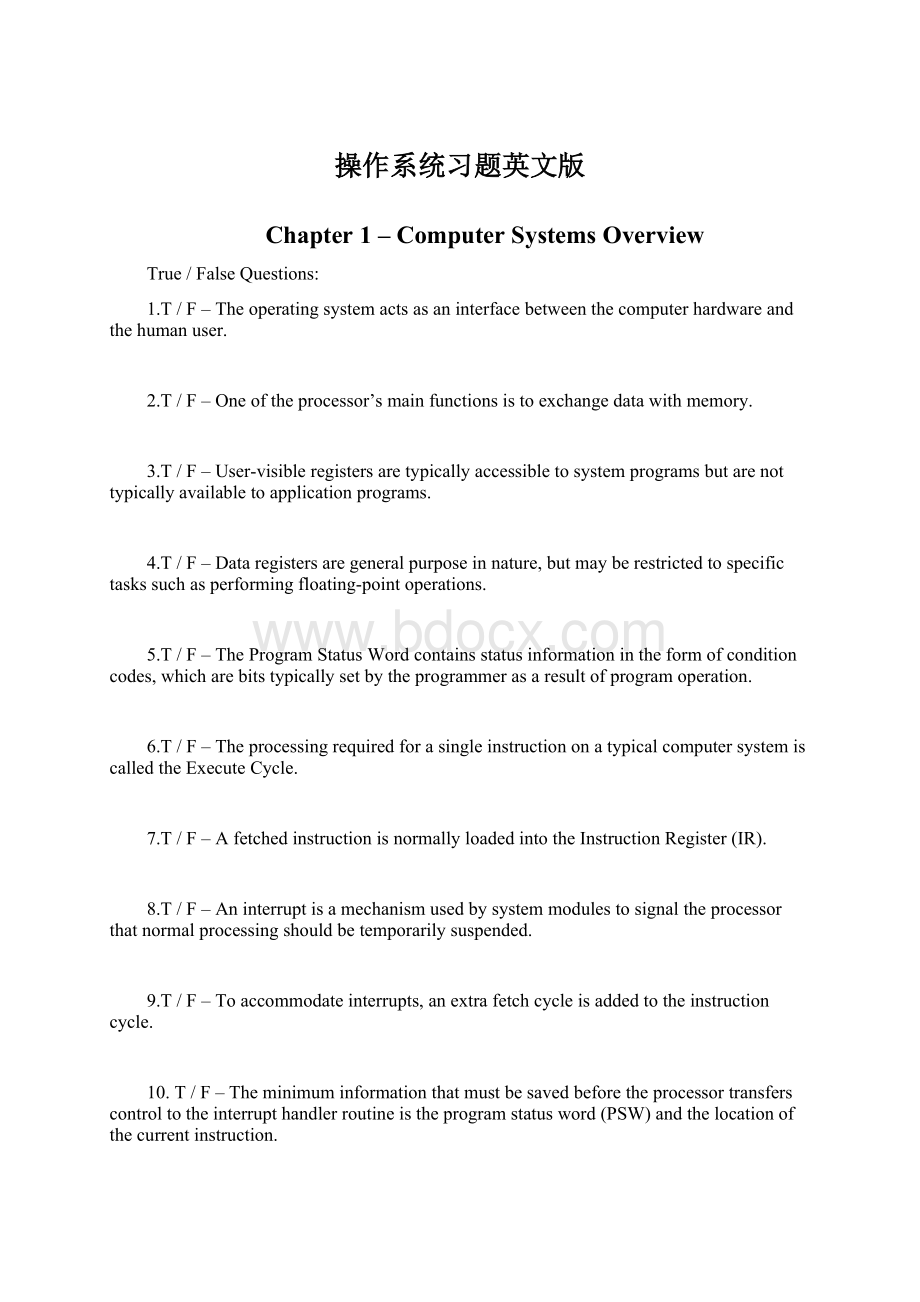操作系统习题英文版Word格式文档下载.docx
《操作系统习题英文版Word格式文档下载.docx》由会员分享,可在线阅读,更多相关《操作系统习题英文版Word格式文档下载.docx(9页珍藏版)》请在冰豆网上搜索。

12.T/F–Multiprogrammingallowstheprocessortomakeuseofidletimecausedbylong-waitinterrupthandling.
13.T/F–Inatwo-levelmemoryhierarchy,theHitRatioisdefinedasthefractionofallmemoryaccessesfoundintheslowermemory.
14.T/F–Cachememoryexploitstheprincipleoflocalitybyprovidingasmall,fastmemorybetweentheprocessorandmainmemory.
15.T/F–Incachememorydesign,blocksizereferstotheunitofdataexchangedbetweencacheandmainmemory
16.T/F–TheprimaryproblemwithprogrammedI/OisthattheprocessormustwaitfortheI/OmoduletobecomereadyandmustrepeatedlyinterrogatethestatusoftheI/Omodulewhilewaiting.
MultipleChoiceQuestions:
1.Thegeneralroleofanoperatingsystemisto:
a.Actasaninterfacebetweenvariouscomputers
b.Provideasetofservicestosystemusers
c.Managefilesforapplicationprograms
d.Noneoftheabove
2.Thefourmainstructuralelementsofacomputersystemare:
a.Processor,Registers,I/OModules&
MainMemory
b.Processor,Registers,MainMemory&
SystemBus
c.Processor,MainMemory,I/OModules&
3.Thetwobasictypesofprocessorregistersare:
a.User-visibleandControl/Statusregisters
b.ControlandStatusregisters
c.User-visibleanduser-invisibleregisters
4.Addressregistersmaycontain:
a.Memoryaddressesofdata
b.Memoryaddressesofinstructions
c.Partialmemoryaddresses
d.Alloftheabove
5.AControl/Statusregisterthatcontainstheaddressofthenextinstructiontobefetchediscalledthe:
a.InstructionRegister(IR)
b.ProgramCounter(PC)
c.ProgramStatusWord(PSW)
6.Thetwobasicstepsusedbytheprocessorininstructionprocessingare:
a.FetchandInstructioncycles
b.InstructionandExecutecycles
c.FetchandExecutecycles
7.Afetchedinstructionisnormallyloadedintothe:
c.Accumulator(AC)
8.Acommonclassofinterruptsis:
a.Program
b.Timer
c.I/O
9.Whenanexternaldevicebecomesreadytobeservicedbytheprocessor,thedevicesendsthistypeofsignaltotheprocessor:
a.Interruptsignal
b.Haltsignal
c.Handlersignal
10.Informationthatmustbesavedpriortotheprocessortransferringcontroltotheinterrupthandlerroutineincludes:
a.ProcessorStatusWord(PSW)
b.ProcessorStatusWord(PSW)&
Locationofnextinstruction
c.ProcessorStatusWord(PSW)&
Contentsofprocessorregisters
11.Oneacceptedmethodofdealingwithmultipleinterruptsisto:
a.Defineprioritiesfortheinterrupts
b.Disableallinterruptsexceptthoseofhighestpriority
c.Servicetheminround-robinfashion
12.Inauniprocessorsystem,multiprogrammingincreasesprocessorefficiencyby:
a.Increasingprocessorspeed
b.Takingadvantageoftimewastedbylongwaitinterrupthandling
c.Eliminatingallidleprocessorcycles
13.Asoneproceedsdownthememoryhierarchy.,frominboardmemorytoofflinestorage),thefollowingcondition(s)apply:
a.Increasingcostperbit
b.Decreasingcapacity
c.Increasingaccesstime
14.Small,fastmemorylocatedbetweentheprocessorandmainmemoryiscalled:
a.WORMmemory
b.Cachememory
c.CD-RWmemory
d.Noneoftheabove
15.Whenanewblockofdataiswrittenintocachememory,thefollowingdetermineswhichcachelocationtheblockwilloccupy:
a.Blocksize
b.Cachesize
c.Writepolicy
16.DirectMemoryAccess(DMA)operationsrequirethefollowinginformationfromtheprocessor:
a.AddressofI/Odevice
b.Startingmemorylocationtoreadfromorwriteto
c.Numberofwordstobereadorwritten
Questions
,,,
Problems
,,,,
Chapter2–OperatingSystemOverview
1.T/F–Anoperatingsystemcontrolstheexecutionofapplicationsandactsasaninterfacebetweenapplicationsandthecomputerhardware.
2.T/F–Theoperatingsystemmaintainsinformationthatcanbeusedforbillingpurposesonmulti-usersystems.
3.T/F–Theoperatingsystemtypicallyrunsinparallelwithapplicationprograms,onit’sownspecialO/Sprocessor.
4.T/F–Oneofthedrivingforcesinoperatingsystemevolutionisadvancementintheunderlyinghardwaretechnology.
5.T/F–Inthefirstcomputers,usersinteracteddirectlywiththehardwareandoperatingsystemsdidnotexist.
6.T/F–Inabatch-processingsystem,thephrase“controlispassedtoajob”meansthattheprocessorisnowfetchingandexecutinginstructionsinauserprogram.
7.T/F–Uniprogrammingtypicallyprovidesbetterutilizationofsystemresourcesthanmultiprogramming.
8.T/F–Inatimesharingsystem,auser’sprogramispreemptedatregularintervals,butduetorelativelyslowhumanreactiontimethisoccurrenceisusuallytransparenttotheuser.
9.T/F–Aprocesscanbedefinedasaunitofactivitycharacterizedbyasinglesequentialthreadofexecution,acurrentstate,andanassociatedsetofsystemresources.
10.T/F–Avirtualmemoryaddresstypicallyconsistsofapagenumberandanoffsetwithinthepage.
11.T/F–Implementingprioritylevelsisacommonstrategyforshort-termscheduling,whichinvolvesassigningeachprocessinthequeuetotheprocessoraccordingtoitslevelofimportance.
12.T/F–Complexoperatingsystemstodaytypicallyconsistofafewthousandlinesofinstructions.
13.T/F–Amonolithickernelarchitectureassignsonlyafewessentialfunctionstothekernel,includingaddressspaces,interprocesscommunicationandbasicscheduling.
14.T/F–Thehardwareabstractionlayer(HAL)mapsbetweengenerichardwarecommands/responsesandthoseuniquetoaspecificplatform.
17.Aprimaryobjectiveofanoperatingsystemis:
a.Convenience
b.Efficiency
c.Abilitytoevolve
18.Theoperatingsystemprovidesmanytypesofservicestoend-users,programmersandsystemdesigners,including:
a.Built-inuserapplications
b.Errordetectionandresponse
c.Relationaldatabasecapabilitieswiththeinternalfilesystem
19.Theoperatingsystemisunusualinit’sroleasacontrolmechanism,inthat:
a.Itrunsonaspecialprocessor,completelyseparatedfromtherestofthesystem
b.Itfrequentlyrelinquishescontrolofthesystemprocessorandmustdependontheprocessortoregaincontrolofthesystem
c.Itneverrelinquishescontrolofthesystemprocessor
20.Operatingsystemsmustevolveovertimebecause:
a.Hardwaremustbereplacedwhenitfails
b.Userswillonlypurchasesoftwarethathasacurrentcopyrightdate
c.Newhardwareisdesignedandimplementedinthecomputersystem
21.Amajorproblemwithearlyserialprocessingsystemswas:
a.Setuptime
b.Lackofinputdevices
c.Inabilitytogethardcopyoutput
22.Anexampleofahardwarefeaturethatisdesirableinabatch-processingsystemis:
a.Privilegedinstructions
b.Acompletelyaccessiblememoryarea
c.Largeclockcycles
23.Acomputerhardwarefeaturethatisvitaltotheeffectiveoperationofamultiprogrammingoperatingsystemis:
a.Verylargememory
b.Multipleprocessors
c.I/OinterruptsandDMA
24.Theprincipleobjectiveofatimesharing,multiprogrammingsystemisto:
a.Maximizeresponsetime
b.Maximizeprocessoruse
c.Provideexclusiveaccesstohardware
25.Whichofthefollowingmajorlineofcomputersystemdevelopmentcreatedproblemsintimingandsynchronizationthatcontributedtothedevelopmentoftheconceptoftheprocess
a.Multiprogrammingbatchoperationsystems
b.Timesharingsystems
c.Realtimetransactionsystems
26.Thepagingsysteminamemorymanagementsystemprovidesfordynamicmappingbetweenavirtualaddressusedinaprogramand:
a.Avirtualaddressinmainmemory
b.Arealaddressinmainmemory
c.Arealaddressinaprogram
27.Rel